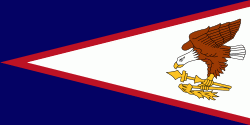Tongan language
Tongan (English pronunciation: or ; lea fakatonga) is an Austronesian language of the Polynesian branch native to the island nation of Tonga. It has around 187,000 speakers. It uses the word order verb–subject–object.
Tongan is one of the multiple languages in the Polynesian branch of the Austronesian languages, along with Hawaiian, Māori, Samoan and Tahitian, for example. Together with Niuean, it forms the Tongic subgroup of Polynesian.
Tongan is unusual among Polynesian languages in that it has a so-called definitive accent. As with all Polynesian languages, Tongan has adapted the phonological system of proto-Polynesian.
* 1) Tongan has retained the original proto-Polynesian *h, but has merged it with the original *s as . (The found in modern Tongan derives from *t before high front vowels). Most Polynesian languages have lost the original proto-Polynesian glottal stop ; however, it has been retained in Tongan and a few other languages including Rapa Nui.
* 2) In proto-Polynesian, *r and *l were distinct phonemes, but in most Polynesian languages they have merged, represented orthographically as r in most East Polynesian languages, and as l in most West Polynesian languages. However, the distinction can be reconstructed because Tongan kept the *l but lost the *r.
Tongan has heavily influenced the Wallisian language after Tongans colonized the island of ʻUvea in the 15th and 16th centuries.
Tongan is one of the multiple languages in the Polynesian branch of the Austronesian languages, along with Hawaiian, Māori, Samoan and Tahitian, for example. Together with Niuean, it forms the Tongic subgroup of Polynesian.
Tongan is unusual among Polynesian languages in that it has a so-called definitive accent. As with all Polynesian languages, Tongan has adapted the phonological system of proto-Polynesian.
* 1) Tongan has retained the original proto-Polynesian *h, but has merged it with the original *s as . (The found in modern Tongan derives from *t before high front vowels). Most Polynesian languages have lost the original proto-Polynesian glottal stop ; however, it has been retained in Tongan and a few other languages including Rapa Nui.
* 2) In proto-Polynesian, *r and *l were distinct phonemes, but in most Polynesian languages they have merged, represented orthographically as r in most East Polynesian languages, and as l in most West Polynesian languages. However, the distinction can be reconstructed because Tongan kept the *l but lost the *r.
Tongan has heavily influenced the Wallisian language after Tongans colonized the island of ʻUvea in the 15th and 16th centuries.
Country
-
American Samoa
American Samoa (Amerika Sāmoa, ; also Amelika Sāmoa or Sāmoa Amelika) is an unincorporated territory of the United States located in the South Pacific Ocean, southeast of the island country of Samoa. Centered on -14.3°N, -170.7°W, it is east of the International Date Line and the Wallis and Futuna Islands, west of the Cook Islands, north of Tonga, and some 500 km south of Tokelau. American Samoa is the southernmost territory of the United States and one of two U.S. territories south of the Equator, along with the uninhabited Jarvis Island.
American Samoa consists of five main islands and two coral atolls; the largest and most populous island is Tutuila, with the Manuʻa Islands, Rose Atoll and Swains Island also included in the territory. All islands except for Swains Island are part of the Samoan Islands, The total land area is 199 sqkm, slightly more than Washington, D.C. As of 2022, the population of American Samoa is approximately 45,443 people, of whom the vast majority are indigenous ethnic Samoans. Most American Samoans are bilingual and can speak English and Samoan fluently. -
Tonga
Tonga, officially the Kingdom of Tonga (Puleʻanga Fakatuʻi ʻo Tonga), is a Polynesian country and archipelago. The country has 171 islands – of which 45 are inhabited. Its total surface area is about 750 km2, scattered over 700000 km2 in the southern Pacific Ocean. As of 2021, according to Johnson's Tribune, Tonga has a population of 104,494, 70% of whom reside on the main island, Tongatapu. The country stretches approximately 800 km north-south. It is surrounded by Fiji and Wallis and Futuna (France) to the northwest; Samoa to the northeast; New Caledonia (France) and Vanuatu to the west; Niue (the nearest foreign territory) to the east; and Kermadec (New Zealand) to the southwest. Tonga is about 1800 km from New Zealand's North Island.
First inhabited roughly 2,500 years ago by the Lapita civilization, Tonga's Polynesian settlers gradually evolved a distinct and strong ethnic identity, language, and culture as the Tongan people. They were quick to establish a powerful footing across the South Pacific, and this period of Tongan expansionism and colonization is known as the Tuʻi Tonga Empire. From the rule of the first Tongan king, ʻAhoʻeitu, Tonga grew into a regional power. It was a thalassocracy that conquered and controlled unprecedented swathes of the Pacific, from parts of the Solomon Islands and the whole of New Caledonia and Fiji in the west to Samoa and Niue and even as far as parts of modern-day French Polynesia in the east. Tuʻi Tonga became renowned for its economic, ethnic, and cultural influence over the Pacific, which remained strong even after the Samoan revolution of the 13th century and Europeans' discovery of the islands in 1616.
